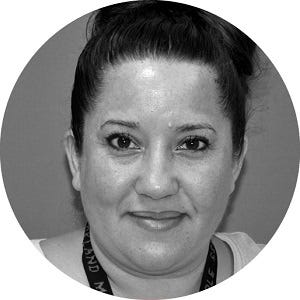A Reflective Lesson Study Results in the Quiet Hum of Learning
An elementary ESOL and reading teacher shares a breakthrough moment in her instruction

“Rather than showing students, I became the observer. Walking around the room, I noted struggling students whom I would later pull for a small group for re-teaching.” — Andrea Robinson-Tejada
Andrea Robinson-Tejada is a National Board Certified Teacher in English/New Language and Literacy: Reading-Language Arts. She teaches ESOL and reading at Parkland Magnet Middle School in Montgomery County.
Ihad been preparing this lesson on complex sentences for weeks. Today was the day: I was filming for Component 3 of National Board Certification. My students began fidgeting when my lesson passed the 30-minute mark. I hurriedly clicked through my slides. Simple sentences magically faded to reveal a complex sentence joined by a conjunction. I included visuals, engaged students with sentences, and gave multiple opportunities to turn and talk. This was the lesson of all lessons — or so I thought.
As I released students to work with partners, I immediately knew I was in trouble. I heard it right away…silence. Despite delivering an intricate lesson, my students had no idea how to form complex sentences.

As I began to analyze my video, it became painfully clear that I had to start over. I began by studying the standards. What I learned completely changed the way I teach and led to students learning in a way I didn’t know was possible.
Mistakes Help Me Improve
Myfirst realization was that my students didn’t need 20 minutes of my modeling to learn a skill. They needed guided practice with immediate feedback. The next time I taught complex sentences, they worked with a partner to manipulate sentence strips while a student manipulated the same sentences on the smartboard. Rather than showing students, I became the observer. Walking around the room, I noted struggling students whom I would later pull for a small group for re-teaching.
Another shift I made was to use a formative assessment after each mini-lesson. This was a game-changer. After a lesson on writing question leads, I was shocked to see only one student could actually do it. For the next class, I had students play a guessing game in table groups using pictures of pets. “What has beady eyes, a fluffy tail, and a pink nose?”
According to Cathryn Berger Kaye, in her article Meaningful Reflection, a Practical Approach, reflection can be…www.edutopia.org
They learned that providing specific adjectives would help their audience identify the pet. They also learned how to write a question lead.
The biggest change I made was having students independently monitor their progress. When I asked students to self-assess previously, I found that what they identified as mastery, I called approaching. This disparity made it clear they didn’t understand the rubric. At the start of our new writing unit, we collaboratively scored several pieces of writing.

With ongoing practice, my students were able to accurately use the rubric to evaluate writing. Afterwards, they selected two goals for their own writing, which they wrote on a goal sheet with a grid of boxes. Students stamped the grid every time they demonstrated their goals in their writing. Students became hyper-focused on their goals and the results were immediate.
Seeing their enthusiasm, I created a Goal Busters bulletin board, a name they suggested. I posted our writing objectives, then added student exemplars along with a mini Polaroid of the student. The board filled with living artifacts of student growth. Even more gratifying, students who had previously self-identified as “bad writers” became confident in their abilities.
I achieved my goal of National Board Certification. While that was laudable, even more important was how the process informed and improved my teaching. I now teach middle school, where my students are far too cool to criss-cross applesauce. Nevertheless, using formative assessments, differentiating instructional goals, and providing specific feedback remain part of my regular practice. And when I release students to work with partners, I hear the quiet hum of learning.

